Raila versus Ruto: Was it a showdown or shutdown?
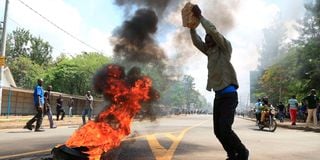
Kisumu residents light bonfires on Jomo Kenyatta Highway during anti-government protests on March 20, 2023. A third-year Maseno University student was shot dead during the protests.
Raila Odinga wore a beige combat suit, a fearsome grimace and a contortion that exaggerated the two wrinkles between his eyes.
He appeared angry and edgy in the one-or-so minute between the moment he emerged from his room at Serena Hotel Nairobi and the moment he was sent scampering into his car after police officers fired a teargas canister towards him and his entourage.
He had been holed up at the hotel for the better part of the day, with hordes of his supporters and a battery of local and international journalists held at bay outside the facility by anti-riot police.
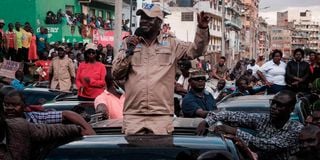
Raila Odinga (centre), the leader of the Kenyan opposition coalition “Azimio la Umoja”, speaks to supporters during a mass rally in Mathare slum in Nairobi on March 20, 2023.
To get in, I informed the police officers and sentries at the gate that I was a guest at the hotel and needed access to my room. After a series of consultations, they squeezed me through a tiny opening in the gate and asked me to run inside as the situation was unpredictable. A group of agitated men had been trying to overrun the gate for hours, and every now and then they would be pushed back by police officers.
The reception area of the usually calm and serene hotel was a hive of activity. Tens of political activists and operatives milled around the huge lobby, their boisterous banter extending all the way from the security desk to the poolside restaurant and the small garden at the back.
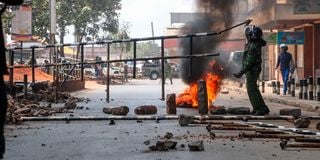
Security officers remove barriers mounted by rioters along Tom Mboya street in Nairobi on March 20, 2023, during a mass action protest staged by Azimio la Umoja coalition leaders led by former Prime Minister Raila Odinga.
At the Aksum Bar, the neat Ethiopian-style tavern overlooking the gardens, Winnie, the Azimio la Umoja One Kenya Coalition leader’s daughter, sat in conversation with a group of about six people.
“I’m inside Serena,” I called the News Desk back at Nation Centre to inform the editors that I had fiddled my way in.
“Great! Is Raila there?”
“It appears so, but I have not seen him. Winnie is here though. And Kalonzo. And Karua. So your guess is as good as mine.”
“Fantastic. Scour the area and check the mood and…”
A commotion ensued just as I was briefing the News Desk. I hang up and rushed back into the lobby, where I found Raila surrounded by about 100 men and women. I elbowed my way through the crowd to take a photo and confirm to the News Desk that the man who had called daylong protests, and who had not been seen in public since the riots had started across the country in the morning, was indeed at a hotel bang in the middle of the city.

Azimio la Umoja One Kenya Coalition leader Raila Odinga, Narc Kenya’s Martha Karua, Wiper leader Kalonzo Musyoka, Jubilee Party’s Jeremiah Kioni and other leaders leave Serena Hotel yesterday.
This image, this confirmation, was important because rumours had started doing the rounds that Raila had been barred from leaving the hotel, and that speculation had been given credence by the heavy police cordon around Serena.
Belligerence of his posture
After a brief chat with the top leadership of Azimio, Raila started making his way towards the heavily barricaded gate. His steps were short, a tad weary and measured. If he was troubled, the belligerence of his posture did not betray it, and neither did the tiny glint in his eye. Instead, he marched on, his gait and bearing like that of a prisoner of war marching to the stake to take a bullet in his chest.
“Good afternoon, sir,” I greeted him as I scrambled to take pictures of him and his entourage with my mobile phone.
“Good afternoon,” he responded.
“What are your plans for the day?”
Before he could answer, Martha Karua, who was walking next to him on his right, waved me away.
“Not now!” she shouted. “Not now! Maybe later.”

Chaotic scenes along Tom Mboya Street in Nairobi as rioters barricade and destroy road barriers during demonstrations called by Azimio la Umoja leader Raila Odinga. Wilfred Nyangaresi | Nation Media Group
As the brigade made its way towards the gate, anti-riot police officers moved into action, barricading the junction of Processional Way and Valley Road. Raila attempted to break through the barrier but was repulsed with a barrage of teargas canisters and volleys of water cannons.
Under a thick cloud of teargas, the spray of hundreds of litres of water and the relentless pop-pop of exploding canisters, Raila was quickly whisked into his car and driven at high speed up Kenyatta Avenue into Cathedral Road at the National Social Security Fund towers junction, and onto Ngong Road.
Here, he attempted to take a left turn into the city centre but was quickly repulsed by police officers. He then made his way up Ngong Road and disappeared into the Upper Hill neighbourhood of the city before, minutes later, turning up on Jogoo Road as he made his way to Kamukunji and Eastleigh.
In the battle for the city, the police had won Day 1 of the riots. Their plan had been simple but meticulously and ruthlessly executed: to prevent Raila and his supporters from accessing the Central Business District, they had erected roadblocks on every road into the city. Small bands of rioters had managed to sneak into the CBD earlier in the day, but they had been quickly dispersed with teargas and volleys of rubber bullets.
At 10.25am the small roundabout at the junction of Wabera Street and City Hall Way had been the theatre of action in the CBD for hours on end as police officers battled a small but determined group of rioters that had congregated at the entrance of Kenyatta International Convention Centre.
Here, with the majesty of the Supreme Court towering over them, young men had hurled stone missiles and epithets at the police officers. Businesses remained shut, with Pronto, the popular restaurant right opposite the County Assembly, going the extra mile to shield its premises with heavy canvas curtains.
A woman overwhelmed by the thick smoke of teargas ran by, screaming her lungs off with her eyes half-closed.
“Don’t worry Mama,” one of the rioters shouted, “unga will soon be retailing at Sh50.” The woman did not utter a word and disappeared into the chaotic maze of Wabera Street.
Chants of “unga!” and “njaa” had rent the air the whole morning, with the protesters echoing Raila’s call to President William Ruto to intervene and reduce the cost of living. Other than the cost of living, Raila’s ultimatum to the President last month spelled out two other demands; opening of the servers of the Independent Electoral and Boundaries Commission (IEBC) to audit the results of the last General Election, and stopping of the ongoing recruitment of IEBC commissioners.
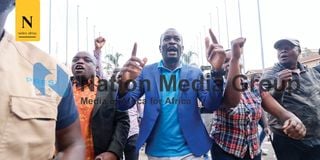
Nairobi Senator Edwin Sifuna among other Nairobi Azimio leaders join protesters in the Nairobi city centre on March 20, 2023.
The President has, however, dismissed Raila’s demands, telling him to “stop bothering me about servers” and asking: “Where in the constitution does it state that servers must be opened?”
“If the constitution talks about me opening the servers, I will obey the law,” Ruto has been categorical, adding with a sense of finality that “the only topic I will discuss is about opening the economy”.
Buried in the chants for cheaper unga yesterday was the refusal by Raila to concede defeat since the Supreme Court ruling on the August 9 election that saw Ruto named the winner. The Azimio leader says he will continue to fight for electoral justice and sees these protests, or maandamano in Kiswahili, as an avenue through which to agitate and perhaps corner the President.
Yesterday’s protests, however, exposed a city of two worlds. As police engaged rioters in running battles at City Hall and outside Kencom, just a few metres away at the bus stop outside Nyayo House all was quiet and calm, with touts calling for passengers and hawkers selling their wares. The same calmness obtained at various other zones that the Nation team visited, including in the typically politically charged Mathare neighbourhood, in Kangemi, in the peri-urban sprawl of Kawangware, along the seven-kilometre expanse of Kiambu Road from the junction with Thika Road, and on Ngong Road.
Heavy cordons
Raila had threatened to lead a march on State House, and the police had reacted by throwing heavy cordons around Ruto’s official residence. At 10.54am we found police officers at the junction of State House Road and Arboretum Drive. We asked them to allow us to drive through but their commander refused us entry, telling us he would let us through if we parked the car and walked on foot. We obliged and were let through.
“Where are you heading, young men?” one of the police officers asked.
“Just doing the rounds to confirm to the nation that the President is safe,” I responded, then asked. “But, afande, why are you calling us ‘young men?’”
The police officer, gun at the ready and kitted for war, smiled, then beamed: “A man can be as young as he likes.”
“That’s true, sir,” I shot back as we ventured into the lonely emptiness of State House Road.
At the intersection leading to the Nairobi Arboretum, just a few metres past the Crawford Business Park, a man and woman stood guard and asked us to introduce ourselves.
After exchanging pleasantries, the man introduced himself as John Ouko and said he was the Station Manager of the Nairobi Arboretum.
“So what are you doing here? The park is about a kilometre away,” I posed.
“It’s all quiet inside,” he explained. “We’ve only had about 20 guests at the park since morning, and they have all left because of the chaos of the day, so we are standing here to welcome anyone who would like to pay us a visit.”
The Nairobi Arboretum receives between 500 and 1,800 visitors on quiet days, and Ouko said the traffic into the park yesterday was one of the worst he has witnessed in recent days.
From State House, we made our way to Kawangware through Congo and Maragoli Stage and onwards onto Naivasha Road. The plan was to survey the junction of Naivasha Road with Ngong Road as this was the scene of ugly clashes between Kibera and Kawangware residents during the 2007/08 post-election violence that birthed the Grand Coalition Government.
Here, however, all was quiet, as was the small road leading to Jamhuri off the main highway. At Toi Market, however, the smell of teargas hang in the air long after police had left. A few minutes earlier, a man had been shot and injured here during clashes with security officers. The shops, stalls and makeshift garages that dot this small neighbourhood were all shut down, with dozens of police officers on foot patrol.
And then, at 11.50am, we made our way into Kibera, the slum settlement sandwiched between Ngong Road and the Southern Bypass that has been the home of opposition politics for decades.
If the city was restive, Kibera was a battleground. Hundreds of young men stared down at heavily armed police officers, chanting war songs and berating the police to venture further inside if they wanted to face the wrath of a thousand hungry bellies.
The police had ringed-in the protesters, containing them within the slum but not venturing in. The plan worked particularly well as the rioters, blocked from accessing Ngong Road, the Southern Bypass and Lang’ata Road, could not leave the slum and cause mayhem elsewhere. Every now and then, a band of protesters would attempt to breach the security cordon, and every now and then they would be pushed back with a barrage of teargas and the spray of water cannons. Then the police would retreat, clamber into their trucks, and wait for the next provocation.
“This is annoying,” an exasperated police officer said, referring to the hours-long back-and-forth with the rioters and the wall-to-wall coverage of every counter by tens of journalists.
“We can’t work like this,” he continued. “We would have dealt with these bands long ago but we can’t when the media is recording everything we do. And maybe human rights crusaders are embedded here as well so that they can start making noise about police brutality.”
The police have in the past been accused of excessive force when dealing with protesters, and it was evident yesterday, especially under the glare of television cameras, that they were measured in their confrontations with the rioters.
However, even under the circumstances, the Nation obtained evidence of what appeared to be the use of live bullets. We collected three spent catridges of live bullets in the course of filing this report, one outside City Hall in the middle of the city and two in Kibera. The team also collected several rubber bullets.
Horrific injuries
While the exasperated police officer in Kibera protested working under the glare of cameras, and exercised caution in dealing with rioters in various parts of the city, security forces across the world have been accused of routinely misusing rubber and plastic bullets and other law enforcement weapons to violently suppress peaceful protests and cause horrific injuries and deaths. A report by Amnesty International this month called for strict controls on their use and a global treaty to regulate their trade.
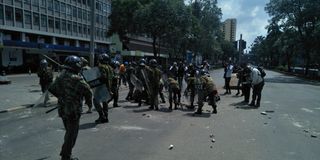
Police officers along Kenyatta Avenue, Nairobi as they engaged rioters in running battles on March 20, 2023.
The report was based on research in more than 30 countries over the last five years, which documented how thousands of protesters and bystanders have been maimed and dozens killed by the “often reckless and disproportionate use of less lethal law enforcement weaponry”, including kinetic impact projectiles such as rubber bullets, as well as the firing of rubberised buckshots and tear gas grenades fired directly at demonstrators.
The weapons, the report noted, have led to permanent disability in hundreds of cases and many deaths. There has been an alarming increase in eye injuries, including eyeball ruptures, retinal detachments and the complete loss of sight, as well as bone and skull fractures, brain injuries, the rupture of internal organs and haemorrhaging, punctured hearts and lungs from broken ribs, damage to genitalia and psychological trauma.
The city and its environs was littered with as many of these projectiles as it was with stones and upturned road dividers yesterday. In the evening, after a winding and chaotic tour of the Eastlands zone of the city, Raila promised this was just the beginning of a series on weekly protests across the country. Every Monday, he said, he would lead his troops to the city until Ruto capitulates.
In the battle for the soul of the nation, two political heavyweights are once again staring each other down. One has access to state instruments of violence, the other believes his power rests with the masses. Who will blink first?





